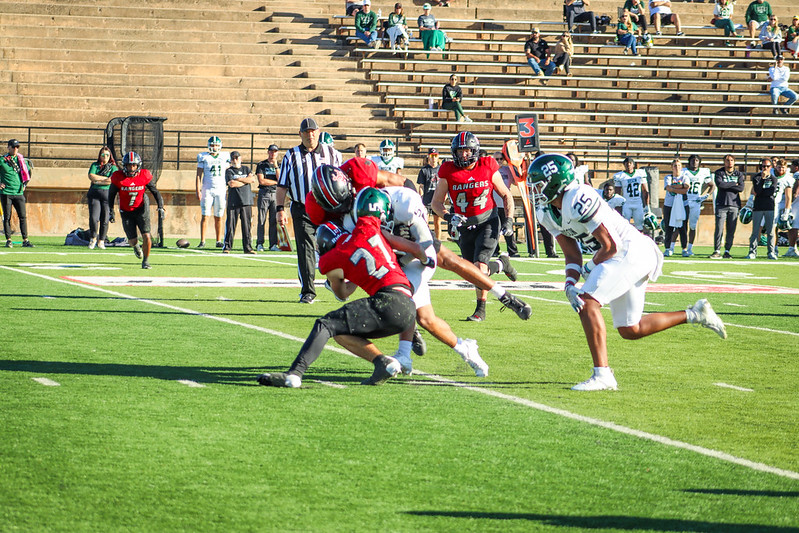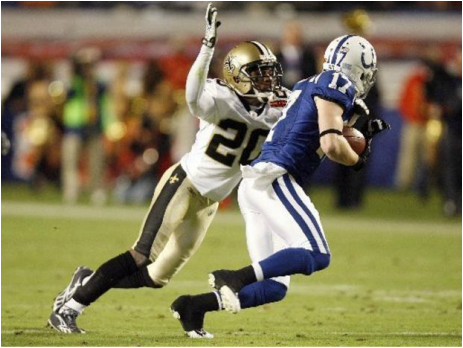By ELY NOBLE
Senior Reporter
Randall Gay didn’t see the hit coming. As cornerback.
As a cornerback for the New England Patriots in 2005, big hits were just a part of the job.
The game was different back then, tough and unforgiving.
Gay felt his head rattle as another player slammed into him, helmet-to helmet, a hit that would get a 15-yard penalty.
Lying on the field, Gay though to himself, “this is just football.”
Years later, Gay watched as the NFL made big changes to the game.
“Back then, the big hits were how you got noticed,” he said. “Now, you see the league trying to make sure players are healthy after they retire.”
Over the past 20 years, the NFL has worked to make football safer. Hits that were once celebrated are now seen as dangerous.
Concussions, neck injuries and long-term brain damage, like Chronic Traumatic Encephalopathy (CTE), have pushed the league to take action.
New rules were introduced to protect players while keeping the game exciting.
“I wasn’t sure about the new rules at first,” Gay said. “But after seeing what some of my teammates are going through, I think it was the right thing to do.”
In the early 2000s, the NFL started making changes to keep players safe.
The first rule that stood out was the “no-contact” rule for wide receivers, put in place in 2004.
This rule stopped defenders from hitting receivers more than five yards from the line of scrimmage.
It didn’t just make the game more exciting by allowing more passing, it also helped reduce violent collisions.
Then, in 2009, after New England Patriots quarterback Tome Brady suffered a season ending knee injury, the NFL created a rule to protect quarterbacks.
This rule, known as the “Brady Rule,” banned defenders from hitting quarterbacks below the knee. ESPN reported that this change was made to prevent serious injuries to one of the game’s most important players.
These changes laid the groundwork for what was to come.
The NFL was starting to realize that player safety needed to be a bigger priority.
In the late 2000s, concussions became a major concern. Many former players started suffering from CTE, a brain disease caused from repeated injuries to the head.
As the New York Times reported, players were dealing with memory loss, depression and other serious health problems after they stepped away from football.
The Concussion Legacy Foundation has been a key group pushing the NFL to take concussions more seriously.
In the past, players often times would hide their injury to stay in the game.
Now, with new rules in place, the NFL requires players to pass a test before they can return to play after a head injury.
In 2015, the NFL took another big step by adding concussion spotters.
These were certified doctors that would watch the game closely and can stop play if they think a player has a concussion.
According to NFL.com, this has made a big difference in catching concussions early.
One of the biggest changes to the game has been the way players tackle.
In the past, hard hits hard hits were celebrated, especially when defenders led with their helmets.
But these hits also caused a lot of concussions and neck injuries.
In 2013, the NFL introduced a rule banning players from hitting with the crown of their helmets.
This rule doesn’t just apply to defensive players but also to running backs, who used to lower their head to power though defenders.
This change forced players to tackle and run differently, focusing more on form and safety.
“Back in my day, it was all about hitting fast and hard,” Devery Henderson, former receiver for New Orleans Saints said. Now, players have to think about how they hit. It’s not just about the play anymore, it’s about safety.
This rule change helped reduce the number of head injuries and neck injuries.
Some fans complained that the game was becoming “soft,” but many players, including Gay, agreed that it was necessary. “Football will always be physical,” Gay said. “But we have to be smarter about it.”
While the NFL was changing the rules, they were also working in better equipment to keep players safe.
One of the biggest improvements has been in helmet technology. Since 2010, helmets have been designed to better protect players from concussions.
In 2023, The Athletic reported that the NFL is now creating position specific helmets.
These helmets were designed for the different ways players get hit. For example, linemen, who face short, powerful hits, will have helmets built to protect against those kinds of hits.
These changes have helped reduce injuries, especially in practices where players wear extra padding over their helmets.
The NFL’s concussion protocol has become one of the most talked-about changes in sports. Before, players would often ignore their injuries and keep playing.
But now, the NFL requires players to pass tests before they can return to the field after a head injury.
Some players get frustrated with these new rules. They want to get back into the game as soon as possible. But the NFL has made it clear that player health is more important than winning.
“Back in the day, you wanted to get back in the game, no matter how bad the hit was,” Henderson said.
“But now they know better. It’s important to heal up before going back out to the field.”
The NFL’s rule changes have changed the culture of football. The game is still fast and physical, but players and coaches are more focused on staying healthy. While some fans miss the big hits of the past, most agree these changes were necessary to protect players.
As The Athletic pointed out, the new rules have made the game safer, and the number of injuries has gone down. The NFL continues to look for ways to improve player safety, making sure that players can enjoy long careers without risking their health.
Randall Gay, looking back on the time he spent playing football in college and in the NFL, sees the changes as a step in the right direction. “Football is still a tough game,” he said. But now, it looks like there doing it in a way that gives the players a better chance to walk away healthy after their time in the league passes by.



